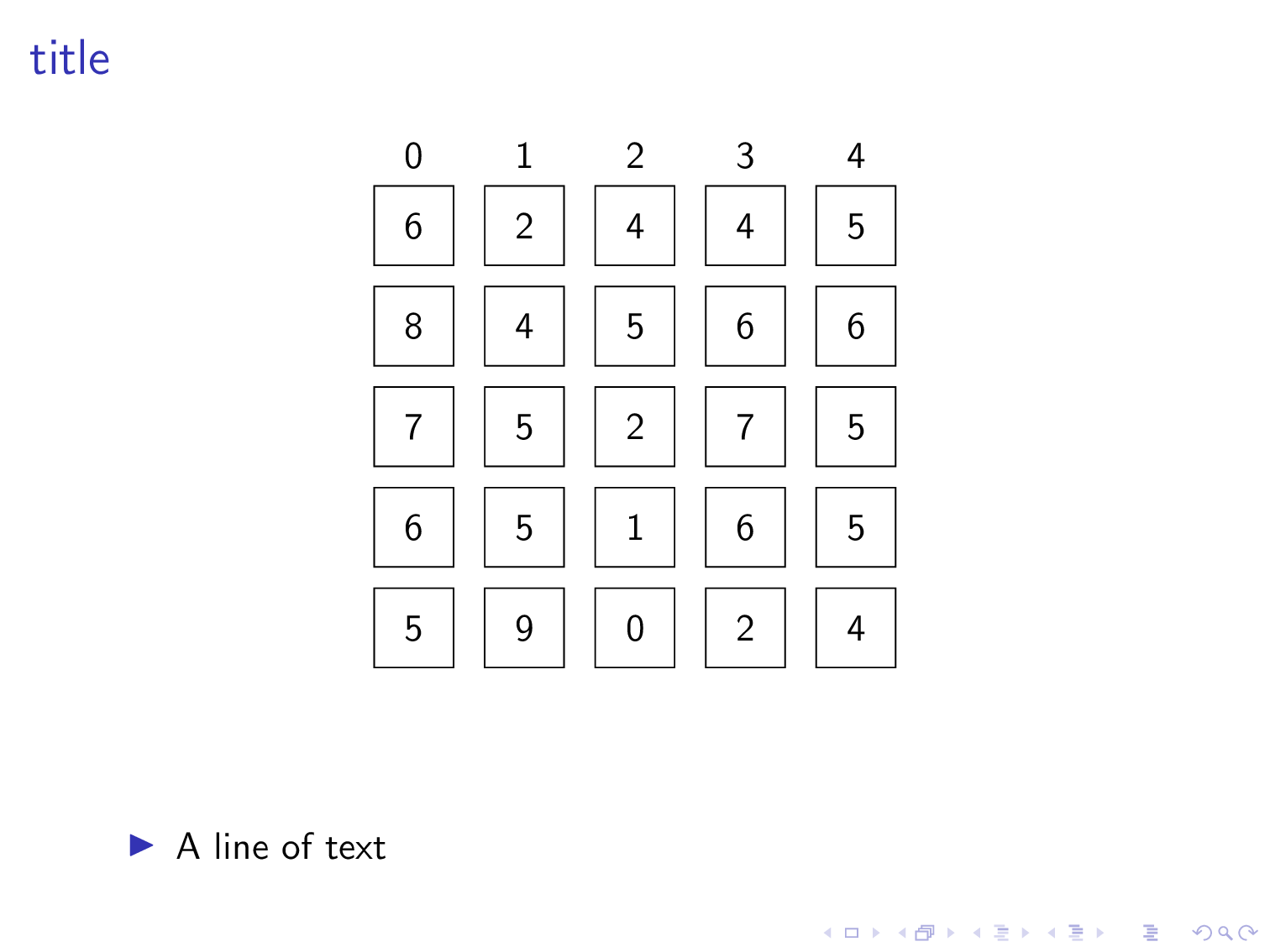
Eu tenho uma série de slides/transições mostrando uma matriz onde insiro algumas lacunas entre colunas e números de círculo e em um ponto adiciono uma linha extra na parte inferior. Eu gostaria que a matriz permanecesse no mesmo lugar verticalmente e que todos os elementos (que estão dentro de uma caixa) permanecessem no mesmo lugar quando tudo o que faço é circular um número ou adicionar uma linha na parte inferior da matriz (veja o exemplo para o que isso significa exatamente). Basicamente, eu gostaria que ele parasse de pular tanto quanto possível. Como posso fazer isso?
Aqui está um exemplo bastante longo que mostra o problema:
\documentclass{beamer}
\usepackage{tikz}
\usetikzlibrary{arrows.meta, calc, matrix}
\newcommand\Circle[1]{%
\tikz[baseline=(char.base)]\node[circle,draw,inner sep=2pt] (char) {#1};}
\begin{document}
\begin{frame}[fragile]
\frametitle{title}
\begin{center}
\begin{tikzpicture}
\matrix (m) [matrix of nodes,
nodes={draw, minimum size=8mm},
column sep=3mm,
row sep=2mm,
row 1/.style={nodes={draw=none}}]
{
0 & 1 & 2 & 3 & 4 \\[-3mm]
6 & 2 & 4 & 4 & 5 \\
8 & 4 & 5 & 6 & 6 \\
7 & 5 & 2 & 7 & 5 \\
6 & 5 & 1 & 6 & 5 \\
5 & 9 & 0 & 2 & 4 \\
};
\end{tikzpicture}
\end{center}
\begin{itemize}
\item A line of text
\end{itemize}
\end{frame}
\begin{frame}[fragile]
\frametitle{title}
\begin{center}
\begin{tikzpicture}
\matrix (m) [matrix of nodes,
nodes={draw, minimum size=8mm},
column sep=3mm,
row sep=2mm,
row 1/.style={nodes={draw=none}}]
{
0 & 1 & 2 & 3 & 4 \\[-3mm]
6 & 2 & 4 & 4 & 5 \\
\Circle{8} & 4 & \Circle{5} & 6 & \Circle{6} \\
7 & 5 & 2 & \Circle{7} & 5 \\
6 & 5 & 1 & 6 & 5 \\
5 & \Circle{9} & 0 & 2 & 4 \\
& & & & \\
\hline \\
8 & 9 & 5 & 7 & 6 \\
};
\end{tikzpicture}
\end{center}
\begin{itemize}
\item Some text
\end{itemize}
\end{frame}
\begin{frame}[fragile]
\frametitle{title}
\begin{center}
\begin{tikzpicture}
\matrix (m) [matrix of nodes,
nodes={draw, minimum size=8mm},
column sep=3mm,
row sep=2mm,
row 1/.style={nodes={draw=none}}]
{
0 & 1 &[5mm] 2 &[5mm] 3 & 4 \\[-3mm]
6 & 2 & 4 & 4 & 5 \\
8 & 4 & \Circle{5} & 6 & 6 \\
7 & 5 & 2 & 7 & 5 \\
6 & 5 & 1 & 6 & 5 \\
5 & 9 & 0 & 2 & 4 \\
& & & & \\
\hline \\
8 & 9 & 5 & 7 & 6 \\
};
\end{tikzpicture}
\end{center}
\end{frame}
\begin{frame}[fragile]
\frametitle{title}
\begin{center}
\begin{tikzpicture}
\matrix (m) [matrix of nodes,
nodes={draw, minimum size=8mm},
column sep=3mm,
row sep=2mm,
row 1/.style={nodes={draw=none}}]
{
0 & 1 &[5mm] 2 & 3 & 4 \\[-3mm]
6 & 2 & 4 & 4 & 5 \\
8 & 4 & 5 & 6 & 6 \\
7 & 5 & 2 & 7 & 5 \\
6 & 5 & 1 & 6 & 5 \\
5 & 9 & 0 & 2 & 4 \\
& & & & \\
\hline \\
8 & 9 & 5 & 7 & 6 \\
};
\end{tikzpicture}
\end{center}
\end{frame}
\begin{frame}[fragile]
\frametitle{title}
\begin{center}
\begin{tikzpicture}
\matrix (m) [matrix of nodes,
nodes={draw, minimum size=8mm},
column sep=3mm,
row sep=2mm,
row 1/.style={nodes={draw=none}}]
{
0 & 1 & 2 &[5mm] 3 &[5mm] 4 \\[-3mm]
6 & 2 & 4 & 4 & 5 \\
8 & 4 & 5 & 6 & 6 \\
7 & 5 & 2 & 7 & 5 \\
6 & 5 & 1 & 6 & 5 \\
5 & 9 & 0 & 2 & 4 \\
& & & & \\
\hline \\
8 & 9 & 5 & 7 & 6 \\
};
\end{tikzpicture}
\end{center}
\end{frame}
\begin{frame}[fragile]
\frametitle{title}
\begin{overlayarea}{\linewidth}{\textheight}
\begin{center}
\begin{tikzpicture}
\matrix (m) [matrix of nodes,
nodes={draw, minimum size=8mm},
column sep=3mm,
row sep=2mm,
row 1/.style={nodes={draw=none}}]
{
0 & 1 & 2 &[5mm] 3 &[5mm] 4 \\[-3mm]
6 & 2 & 4 & 4 & 5 \\
8 & 4 & 5 & 6 & 6 \\
7 & 5 & 2 & \Circle{7} & 5 \\
6 & 5 & 1 & 6 & 5 \\
5 & 9 & 0 & 2 & 4 \\
& & & & \\
\hline \\
8 & 9 & 5 & 7 & 6 \\
};
\end{tikzpicture}
\end{center}
\pause
\begin{itemize}
\item More text
\end{itemize}
\end{overlayarea}
\end{frame}
\end{document}
Responder1
Eu desenharia a matriz apenas uma vez e usaria overlay-beamer-stylespara adicionar as alterações. Seu \Circledcomando aninha tikzpictures, eu o substituí por um circledestilo e uma variação circled onque adiciona o círculo apenas em algumas sobreposições específicas. Por exemplo
|[circled on=<{2,6,7}>]| 7
circula o nó 7 apenas nas sobreposições 2, 6 e 7. Também adicionei um exemplo de como você pode usar a altchave para alterar a separação de colunas de colunas específicas em determinadas sobreposições,
alt=<2>{column 2/.style={column sep=7mm},column 3/.style={column sep=7mm}}{},
mas não tive paixão para implementar todos eles.
\documentclass{beamer}
\usepackage{tikz}
\usetikzlibrary{arrows.meta, calc, matrix,overlay-beamer-styles}
\tikzset{circled/.style={path picture={
\draw let \p1=($(path picture bounding box.north east)-(path picture bounding
box.south west)$),\n1={min(\x1,\y1)/2.2} in
(path picture bounding box.center) circle[radius=\n1];}},
circled on/.style={alt=#1{circled}{}}}
\begin{document}
\begin{frame}[fragile,t]
\frametitle{title}
\centering
\begin{tikzpicture}
\matrix (m) [matrix of nodes,
nodes={draw, minimum size=8mm},
column sep=3mm,
alt=<2>{column 2/.style={column sep=7mm},column 3/.style={column sep=7mm}}{},
% you need to add the other variations of the column seps here
row sep=2mm,
row 7/.style={visible on=<4-5>},
row 1/.style={nodes={draw=none}}] (mat)
{
0 & 1 & 2 & 3 & 4 \\[-3mm]
6 & 2 & 4 & 4 & 5 \\
|[circled on=<2>]| 8 & 4 & |[circled on=<{2,3}>]| 5 & 6 & |[circled on=<2>]| 6 \\
7 & 5 & 2 & |[circled on=<{2,6,7}>]| 7 & 5 \\
6 & 5 & 1 & 6 & 5 \\
5 & |[circled on=<2>]| 9 & 0 & 2 & 4 \\[2mm]
8 & 9 & 5 & 7 & 6 \\
};
\path (mat-6-1.south) -- (mat-7-1.north) coordinate[midway](aux);
\draw[visible on=<{4,5}>] (mat.west|-aux) -- (mat.east|-aux);
\end{tikzpicture}
\only<1>{\begin{itemize}
\item A line of text
\end{itemize}}
\only<2>{\begin{itemize}
\item Some text
\end{itemize}}
\only<7>{\begin{itemize}
\item More text
\end{itemize}}
\end{frame}
\end{document}
Como você pode ver, não há mais saltos e código muito mais curto (e, mesmo que você não necessariamente veja desta forma, o mais importante é que não há mais tikzpictures aninhados).
TERMO ADITIVO: adicionada uma linha extra que só é visível em determinadas sobreposições e separada por uma linha. A visibilidade é controlada por
row 7/.style={visible on=<4-5>},
e
\draw[visible on=<{4,5}>] (mat.west|-aux) -- (mat.east|-aux);
respectivamente.



